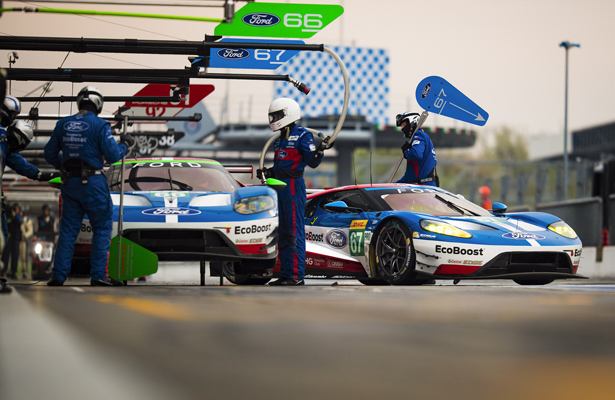
Photo: Drew Gibson/Ford
The FIA and ACO have confirmed details of its new automatic Balance of Performance process for the GTE-Pro class, which will be utilized in all rounds of the FIA World Endurance Championship except for the 24 Hours of Le Mans.
The system, as revealed by Sportscar365 last weekend, will see adjustments being made automatically after certain rounds, according to a calculation tool that eliminates human interpretation or decision-making.
Here’s an overview of the new system:
***The gaps between the different car models will be balanced automatically from one race to the next. The data recorded during the race will be used and, from this, a mathematical algorithm will automatically set the adjustments for the next race. The principles in place meet several criteria established by the ACO, the FIA and the manufacturers.
***The mathematical tool will dictate whether the adjustment should increase the performance of slower cars or slow down the fastest cars in order to maintain the overall performance and stability of the class throughout the season.
***The performance data from only the fastest of each car model (the one having recorded the best level of performance) will be taken into consideration.
***60 percent of the distance covered (the fastest laps) will be used in order to take into account the best of the car’s performance as well as its efficiency with worn tires.
***Straight-line performance is a parameter that will also be considered (not just lap time) in order to achieve similar performance profiles (a higher top speed that may be favorable in the race, for example).
***The calculation also takes into account the performance of each car by sectors at a circuit (these may differ with twisty or fast sections)
***The system also provides rules for determining whether each car is eligible to receive an adjustment. No adjustments will be made if:
-A car has not covered enough distance
-A car has been excessively slow
-There were abnormal weather conditions
***A table has been put in place to define the frequency of adjustments. If the gaps are great, and if they can be measured over a greater number of races, there will be a greater possibility of an adjustment to a car.
***The manufacturers and regulators have decided not to make the first adjustments until after the first two races so as not to over-react. It has therefore been agreed that the first adjustments will be calculated after Spa, for Nürburgring race (Le Mans being treated separately).
***The adjustable variables are: weight and power. The adjustments are capped (maximum 20 kg and 10 KW by race which can be either added or removed)
***An initial BoP will be applicable for the first two events (Silverstone and Spa) which has been defined and published on the basis of multiple parameters:
-Taking into account the performance of cars racing in the final rounds of the 2016 season
-Taking into account the technical data provided by each manufacturer at the time of homologation (data sheet), the measurements taken at the tests carried out at the Ladoux track (dynamic measurements), on the engine dynamometer, as well as those obtained in the Windshear wind tunnel, especially for the new Porsche.
***At the same time, the regulations have been reviewed so that the introduction of new tire specifications (which have a significant impact on performance) is possible only at certain set dates, and in an identical number for each car model for each season.
As also revealed by Sportscar365, the BoP for Le Mans will remain separate and not part of the auto-BoP system, and will be based on a similar system to last year.
Therefore, according to the WEC, “it is not possible for a competitor to freely perform at a lower level before the 24 Hours of Le Mans in the hope of obtaining a favorable adjustment for the main event in June.






















